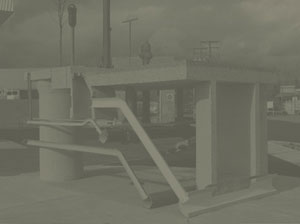Recirculating Crude Oil Fountain for Fort McMurray
A set of pipes arranged as a staggered and diminishing tower, producing endless black ooze that slides back down into a circular pool of oil: this suppurating entropic image, with echoes of Vladmir Tatlin’s unrealized Monument to the Third International from 1919, produces a conflicting image, undermining the concept of the celebratory and affirmative idea of the civic fountain.
While descending the Athabasca River in 1788 Alexander Mackenzie described “bituminous fountains” in his journal; he was referring to the irruptions of petroleum-laden bitumen oozing up along the riverbanks. The Athabasca tar sands cover an area of 140,000 square kilometers, forming the world’s second largest petroleum reserve after Saudi Arabia. The bitumen, an unconventional fuel source with the viscosity of cold molasses, is extracted either through open-pit strip-mining, or steam-injection into purpose-drilled wells. Vast amounts of water and energy are necessary for separation and upgrading to synthetic oil. Enormous quantities of toxic waste left from this process are stored indefinitely in huge tailings ponds, held behind unlined and leaking earthen dams up to 300 feet high; there are now over 50 square miles of these toxic dumps in the region.
The tar sands mega-development is the largest project on the planet, both in scale (the size of Florida) and investment (over $200 billion), and the most environmentally unsustainable and destructive. In the absence of a Canadian national energy self-sufficiency strategy, free-trade agreements guarantee that the majority of low-grade tar-sands bitumen will go south to the US or east to China for refining into value-added gasoline, aviation fuel or diesel. In the tar sands district, staggering quantities of carbon dioxide are produced through energy consumption by “upgrader” separators, and in diluting toxic tar with thinner oils, reducing its viscosity enough for the pipelines. (Much of this diluent needs to be piped to the tar sands.) The burning of enormous quantities of natural gas for steam separation and well extraction, and the destruction through strip-mining of boreal wetlands (a major planetary carbon sink) are both significant contributor to global warming.
Alberta’s token royalty system (1%) ensures corporate profits in unconventional oil are double that of conventional oil, even though the multi-billion dollar infrastructural commitment in the tar sands sets aside virtually no money for remediation and restitution of open-pit extraction, toxic waste ponds, river and groundwater contamination, or species displacement and destruction. Downriver carcinogenic contamination has caused a rash of atypical cancers and major health problems for aboriginals and fish and wildlife, contaminating one of the world’s major river and lake systems. Major new proposed pipelines threaten watershed habitat between Alberta and the BC coast, and greatly-increased tanker traffic through sensitive coastal waterways will inevitably compromise marine ecosystems.
Tar-Sand Video




2001-present

Project for the Tar Sands
2012, model, mixed media, 18” x 24” x 24”
2012, model, mixed media, 18” x 24” x 24”
gregsnider.ca Copyright © 2007 - Greg Snider.
All Rights Reserved. contact: greg@gregsnider.ca
